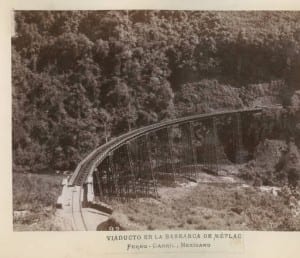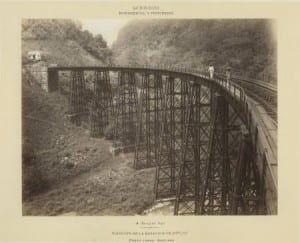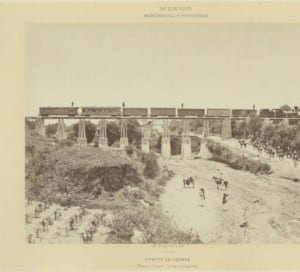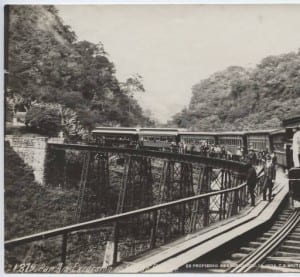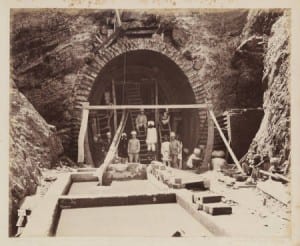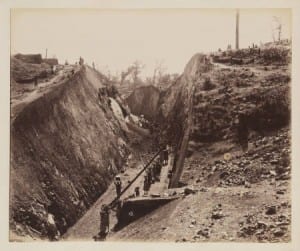Introduction
There are a multitude of differences between the colonization of India and Mexico. Frankly, it is often difficult to come across similarities. However, the industrial revolution introduced an innovative way to access energy through steam and thus sparked the invention of the railroad. This mode of transportation took the world by storm as an economically efficient way to transport people and goods across vast regions. Economic success skyrocketed due to the implementation of railroad travel. What is most interesting in the construction process of the railroads in both India and Mexico is that they occurred similarly in the mid-late 19th and early 20th centuries. The juxtaposition of Mexico’s introduction to railroad travel in post-colonialism compared to India’s introduction during colonialism poses interesting economic, social, and political similarities as a result of this revolutionary mode of transportation.
Mexico
In the late 19th century, Mexican president Porfirio Diaz executed the construction of national railroads in Mexico. The construction began in 1877 and boomed through 1910. During this time there was a “dramatic increase of the Mexican Republic’s railway trackage from 700 miles in 1880 to over 12,000 miles in 1900 and more than 15,000 miles by 1910” (Morales and Schmal).
The Mexican National Railway and the Mexican Central Railway were the two most prevalent railways constructed. The Mexican Central Railway is the more relevant of the two, stretching from central Mexico to the border of the United States. Through a minor connection, the Mexican Central Railway could be taken all the way to Sante Fe, New Mexico, creating an extremely valuable trade route to the United States.
The Mexican National Railway, similarly to the Mexican Central Railway, was a means of transportation to the northern border. It was built starting in Mexico City and ending in Webb County, Texas. It began construction in 1881 but was not accessible until the 20th century. Lorena M. Parlee of the University of California at San Diego stated, “By the turn of the century, the Central and the Nacional [railroads] controlled over half of all railroad track in Mexico and operated the only rail links between Mexico City and the northern border” (Morales and Schmal).
These railroads brought many economic benefits to Mexico. They revolutionized trade in a time of need while the country was growing more and more subordinate to the United States.
The pictures aligned with the text illustrate the landscape in which the two major railways were built in Mexico. At the bottom of the picture there is the script “Ferro Carril Mexicano.” Ferro Carril was a prominent Mexican railroad company during Porfirio Diaz’s reign responsible for a large portion of the construction of the two major railroads. As one can imagine, the uneven surfaces of Mexican landscape provided major obstacles and added difficulty to the construction. To make matters worse, the workers were not appropriately compensated for their work. Teresa Miriam Van Hoy stated, “railroad workers were to conform to a passive, cooperative role in return for which the railroad would confer benefits on them as a natural consequence of its prosperity and that of the economy it stimulated” (Van Hoy 58). Railroad laborers were treated poorly. Porfirio Diaz expected Mexican citizens to labor over railroads for slim to nothing all for the betterment of their country. Laborers in the beginning stages of construction were barely paid for subsistence. As tensions rose and productivity began to suffer, Diaz was forced to up the wages. Yet, “only foreign workers earned more than the minimum” required for living (Van Hoy 50). Economists have calculated that the only backward linkages in the economic success of railroads were the wages. It was up to the citizens themselves to decide whether or not their poor treatment was worth it in the long run.
Although Mexico was fully independent, their laborers on the railways were still oppressed. It may not have been as brutal as it would have been if Mexico were still under colonial powers, but still enough to severely underpay the majority of workers. Diaz had the opportunity to boost the economy through well paying railway jobs in addition to the cash flows that would result from their completion, yet he denied. This goes to show that despite being a free, independent nation similar effects of imperialism can fall through the cracks in the hands of a greedy leader. However, the finished product of a national railroad transportation system sent the Mexican economy into prosperity.
Many markets boomed due to the ability to travel by railway. Mexico’s imports and exports increased tremendously as a result of the quick transportation connecting it to the United States. As this picture illustrates, many freight trains similar to this were used to transport goods. Trains allowed a remarkable amount of material to be moved at once. The increase in exports stimulated job growth. The railroads economically “played a crucial role in the development of northern Mexico, stimulating a mining boom and a tremendous growth in commercial agriculture and ranching” (Morales and Schmal).
This Pan-American train travelled on the Mexican Central Railway. The presence of people gives the railroad a sense of liveliness and excitement. The Mexican Central Railway and Mexican National Railway gave the country something to be excited about and something to be proud of. It created many jobs and led to economic prosperity. Implementation of railroad travel was not only a monetary success but also a nationalist movement that brought pride and joy into the hearts of Mexicans everywhere.
India
India’s construction began a bit earlier than Mexico’s construction. The East India Company had been pushing to construct national railroads for years prior to 1845 when the East India Company’s Court of Directors finally gave in and approved a railroad project. However, construction began slow and treacherous. India’s “inhospitable country” (Banerjee) posed a seemingly insurmountable obstacle.
These pictures to the right reflect this terrain and portray the difficulty of the work the native Indians went through to build the railroads. There were large canyons and valleys, as depicted, all over the country. Not only that, but the workers had to physically dig through many of these canyons to create tunnels similar to the one to the right. This caused a prolonged construction and heavy workforce. Over “10,000 men were employed to drive tunnels and construct viaducts to take a track through the rocky hills and valleys of the Bhore Ghat” near Bombay (Banerjee), and the conditions were awful. Within the first decade of construction, an estimated 45,000 people worked on the country’s railroad construction and over 2,000 died from cholera alone (Banerjee). As seen in the picture below, the Indians were subjected to living in small huts and travelled in bulk building the railroads, which would primarily be used by the East India Company.
In the years 1850-1870 India developed the fourth largest railroad system in the world, connecting almost the entire country. It is also estimated that 10 million people worked on the railroads throughout the entirety of their construction. The British took full advantage of their imperialism and exploited railroad workers, exposing them to disease, malnutrition, and exhaustion. Despite the brutality of construction, the railroads were completed and like many other national railways, led to economic success.
Once the laborers overcame the harsh Indian landscape, the British reaped the benefit of the railways. The trade increased tremendously, from “traveling no more than 30 km per day” to transporting commodities up to 600 km in a day (Donaldson). The British maximized their profits by only enabling military travel and product trade to take place by railroad, leaving the natives exempt from the luxury. Marginal Revolution University states, “if we take the period from 1870 to 1913, it’s been estimated that over those years railroads accounted for about 20 percent of India’s economic growth” (MRUniversity).
Another important economic feat achieved was price dispersion. Dan Bogart and Latika Chaudhary express that the economy “played a major role in integrating markets” (Bogart and Chaudhary 1). The British were able to nationalize the price of many agricultural goods. With the prices of transportation much lower and evenly priced goods sprouting from all parts of the country, the economy was able to flourish. However, the implementation of interconnection proved to be a major factor in the downfall of the British East India Company.
In the beginning stages of railroad travel, the British assumed native travel could be regulated and kept to a minimum. Their assumption proved to be far from the truth. Indians turned out to be devout travellers, given that in “the first five years passenger journeys increased fivefold from about 535,000 to more than 2,700,000” and eventually jumping to 11 3/4 millions to 16 millions between 1864 and 1869 (Sanyar 43). The railroads created a strong bond between Indians. It enabled people to travel the country and explore, eventually leading to a strong sense of nationalism. When the millions of natives travelled across their country their national pride grew and enabled a unified identity. This appreciation for their land stood as motivation to revolt against colonialism and revert back to Indian tradition.
Although the initial success of the Indian railroads benefitted the British, the infrastructure proved to contribute heavily towards India’s freedom. Revolutions are most successful when the oppressed show utmost togetherness. Indian railroads provided citizens with the means to come together, meet other Indians from different parts of the country, and ultimately realize their independence was worth protesting for.
The Connection
We are able to decipher important connections via analysis of both Mexican and Indian national railroads’ effect on economic and social aspects of society. Both railroad systems sparked nationalist movements in the respective countries. Also, even though Mexico was in the post-colonial stage, laborers were still exploited and exposed to oppression just as the Indian workers were. Thirdly, it is clear that the revolutionary transportation led to immense economic booms in both countries. Not only do these connections explain valuable knowledge of Mexico and India alone, but also the overall effect of infrastructure in colonial nations.
Nationalism is an invaluable trait of many strong countries. It is extremely important to have a nation banded together, showing strength and pride. Railroads connect citizens of their respective countries together. In countries under colonial rule, as seen in Mexico and India, revolution is the tool to overthrow an empire. Although railway systems do not directly lead to revolts, they are undeniably factors in the growth of nationalism, which can be the deciding factor between imperialism and independence.
Both Indian and Mexican workers were exploited while building their national railroads. Whether it was with low wages, malnutrition, exposure to disease, or being forced to work to the bone most workers suffered some form of oppression during their time on site. This comes as a surprise given the Mexican workers were not under an imperial government, but shows that leaders of a free nation could exploit their own citizens in similar ways colonial powers used exploitation. It is easier to see through the pictures that Indian workers were stuck in poor conditions and more difficult obstacles to overcome during construction. Overall, railroad construction conveys menial workers can be exploited in a country in any stage of colonialism.
The economic results of the railroads were positive for both India and Mexico. Both spent a relatively small amount of money compared to the unbelievable benefits more efficient transportation brought the countries. Economic success due to railroads is applicable to any country that had not yet implemented this mode of travel. The successes of Mexico and India add to a universal conclusion that an increase in transportation leads to quicker turnover of goods, job growth, and a more prosperous economy.
The Industrial Revolution brought the steam engine into the world. This invention led the most powerful countries in the world to construct railroads, giving them an economic and social step up on other countries. Mexico and India built their railroads during the mid-19th century to 20th century, an advantageous time period to be improving means of trade. However, these historical tracks ran much deeper than the surface. They signified strength and prosperity in the people of the country. Railroads allowed citizens to explore their country. Through that exploration individuals discovered faith, tradition, and pride. Ultimately, railroads enabled a freedom that was foreign to Mexicans and Indians alike.
Written by Patrick Summers
Works Cited
Bogart, Dan, and Latika Chaudhary. “Railways in Colonial India: An Economic Achievement?.” Available at SSRN 2073256 (2012).
Cowen, Tyler, and Alex Tabarrok. “MRUniversity: Railroads and Colonial India.” MRUniversity. Accessed April 30, 2015. http://mruniversity.com/courses/development-economics/railroads-and-colonial-india.
Donaldson, Dave. Railroads of the Raj: Estimating the impact of transportation infrastructure. No. w16487. National Bureau of Economic Research, 2010.
Morales, Donna S., and John P. Schmal. “How We Got Here: The Roads We Took to America.” Houston, Texas: Houston Institute for Culture. Retrieved on June 25 (2005).
Rees, Peter W. “Origins of colonial transportation in Mexico.” Geographical Review (1975): 323-334.
Sanyal, Nalinaksha. The Development of Indian Railways. Calcutta: University of Calcutta, 1930. Internet Archive. Web. 9 March 2014.
Van Hoy, Teresa. A social history of Mexico’s railroads: peons, prisoners, and priests. Rowman & Littlefield Publishers, 2008.

